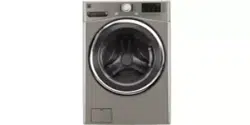Documents: Go to download!
User Manual
- User Manual - (English)
- Installation Instructions - (English)
- Washing Procedures
- Stain Removal
- Common Washing Problems
- Care and Cleaning
- Avoid Service Checklist
Table of contents
User Manual
Washing Procedures
1. Sort laundry into loads that can be washed together.
Sort items by recommended water temperatures and wash time.
- Separate white, light, and colorfast items from dark and noncolorfast items.
- Separate items which shed lint from items which attract lint. Permanent press, synthetic, knit and corduroy items will pick up lint from towels, rugs and chenille bedspreads.
- Separate heavily soiled items from lightly soiled items.
- Separate lacy, sheer and loosely knit items from sturdy items.
- Do not machine wash items containing fiberglass. Small particles of fiberglass left in the drum may stick to fabrics in other loads and cause skin irritation.
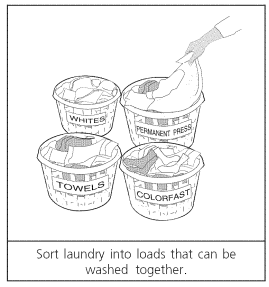
2. Prepare items for washing.
- Empty pockets.
- Brush off lint and dirt. Shake out rugs and beach towels.
- Close zippers, fasten hooks, tie strings and sashes, and remove nonwashable trims and ornaments.
- Remove pins, decorative buttons, belt buckles, and other objects which could be damaged. This also helps protect other items in the wash load.
- Mend rips and tears to prevent further damage during washing.
- Place delicate items such as bras, shoulder pads, hosiery, and belts in a mesh bag to prevent tangling during the wash cycle.
- Turn knit items inside out to prevent pilling.

3. Pretreat stains and heavy soil.
See Stain Removal, pages 6-7, for details.
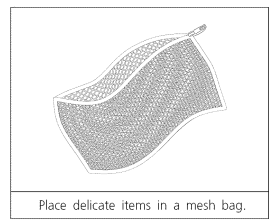
4. Add laundry load to washer.
- Combine large and small items in a load. Load large items first. Large items should not be more than half the total wash load.
- Washing single items such as a sweater, towel or jeans may cause an out-of-balance load. Add 1 or 2 similar items to help balance the load.
- Single heavy items such as a bedspread can be washed separately.
- The washer can be fully loaded, but the items should not be tightly packed. The door should close easily
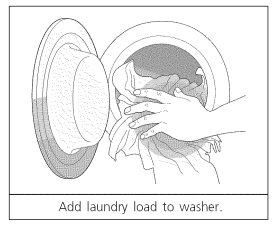
5, Add detergent, bleach and fabric softener to automatic dispenser following these steps:
A. OPENING AAID CLOSING THEDISPENSERDRAWER B.
- Slowly open the dispenser drawer by first sliding the safety latch to the right, then pulling the drawer out until it stops.
- After adding laundry products, slowly closethe dispenser drawer. Closing the drawer too quickly could result in early dispensing of the bleach and fabric softener.
- Dispenser drawer should be completely closed for powdered detergent, bleach and fabric softener to despense.
- Laundry products usedwith powder or liquid detergent, suchascolor-safe bleach, water conditioner, detergent booster, and enzyme products should be added to the empty tub before loading.
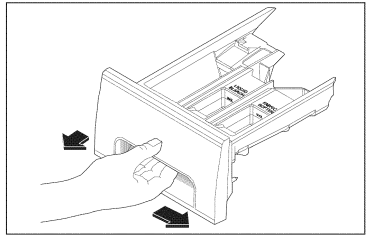
B. DETERGENT
- Add measureddetergenttothe detergent compartment of the dispenser drawer.
- Detergent isflushed from the dispenseratthe beginning of the cycle. Either powdered or liquid detergent can be used. Note: Liquid detergent will drain into the washer drum as it is added.
- Lowsudsing detergentis recommended forthiswasher.
- Use the manufacturer's recommended amount.
- If low sudsing detergent is not available, a reduced amount of regular detergent may be used. Because reducing the amount of detergent mayreduce cleaning, it is important to pretreat stains, sort carefully by color and soil level, and avoid overloading.
- Detergent usage may need to be adjusted for water temperature, water hardness, sizeand soil level of the load.
- For best results, avoid oversudsing.
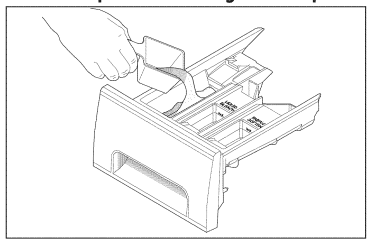
C LIQUID BLEACH
- If desired, measure out the recommended amount of liquid chlorine bleach (not to exceed 1/3 cup (80 mL)) and pour it into the center compartment labeled "Liquid Bleach" and marked with this symbol
 .
. - Do not exceed the maximum fill line. Overfilling can causeearly dispensing of the bleach which could result in damaged clothes.
- Do not pour undiluted liquid chlorine bleach directly onto the load or into the drum. Fabric damage can occur.
- Do not use powdered bleach in the dispenser.
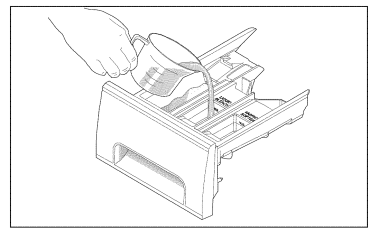
D. FABRICSOFTENER
- If desired, pour the recommended amount of fabric softenerinto the compartment Iab_eled"FabricSoftener" and marked with this symbol
 .
. - Dilute concentrated softeners with warm water to the Fill Line.
- Do not exceed the maximum fill line. Overfilling can cause early dispensing of the fabric softener which could result in stained clothes.
- Do notpour fabricsoftener directly on the wash load.
- Use of a fabric softener dispensing ball is not recommended in tumble action washers.
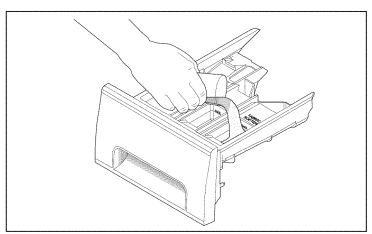
6. Set cycle selector knob and washer controls according to type, size, and soil level of each load.
See Operating Instructions card for your specific model controls.)
7. Start the washer.
Close the washer door and pull out the cycle selector knob. For your safety, the door will automatically lock during the entire wash cycle. The Door Lock indicator light will remain lit until the cycle ends.
- Washer will fill and tumble.
- To stop the washer, push in the cycle selector knob.
- To open the door during tumbling, push in the cycle selector knob. Wait for the water to run off of the door.
- To change a cycle, push in the cycle selector knob and turn it clockwise to the desired setting. Pull out the knob to restart the washer.
- To open the door during a spin cycle, push in the cycle selector knob. The Door Lock indicator light will turn off. Wait 1-2 minutes for the lock to release. The door can then be opened. Do not force open the locked door.
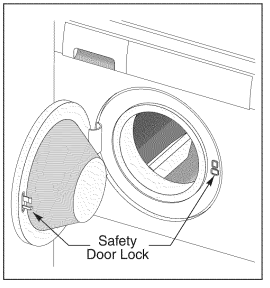
8. Remove items when the cycle is completed.
Place washed items in automatic dryer, line dry, or dry flat as directed by fabric care label. Excesswrinkling, color transfer or odors may develop in items left in the washer after the cycle has ended.
9. General Precautions
- Dispenser drawer should be dosed completely during operation.
- Do not slam the washer door closed or try to force the door open when locked (Door Lock light ON). This could result in damage to the washer.
- DO NOTleave the washer door open. An open door could entice children to hang on the door or crawl inside the washer.
- To avoid damaging the washer and personal injury, DO NOT hang on or lean against the washer door.
- Do not place detergent, bleach or fabric softener containers on top of the washer. They can damage the finish or controls.
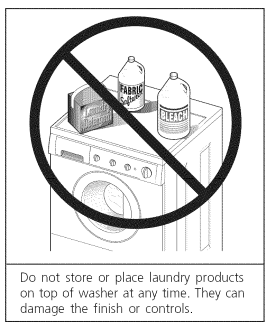
Stain Removal
For successful stain removak
- Remove stains promptly.
- Determine the kind of stain, then follow the recommended treatment in the stain removal chart below.
- To pretreat stains, use a prewash product, liquid detergent, or a paste made from granular detergent and water.
- Use cold water on unknown stains because hot water can set stains.
- Check care label instructions for treatments to avoid on specific fabrics.
- Check for colorfastness by testing stain remover on an inside seam.
- Rinse and wash items after stain removal.
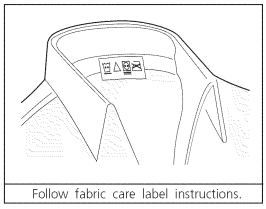
Adhesive tape, chewing gum, rubber cement
- Apply ice. Scrape off excess. Place stain face down on paper towels. Saturate with prewash stain remover or nonflammable dry cleaning fluid.
Baby formula, dairy products egg
- Use product containing enzymes to pretreat or soak stains. Soak for 30 minutes or more. Wash.
Beverages (coffee, tea, soda, juice, alcoholic beverages)
- Pretreat stain. Wash using cold water and bleach safe for fabric.
Blood
- Rinse with cold water. Rub with bar soap. Or, pretreat or soak with product containing enzymes. Wash using bleach safe for fabric.
Candle wax, crayon
- Scrape off surface wax. Place stain face down between paper towels. Press with warm iron until wax is absorbed. Replace paper towels frequently. Treat remaining stain with prewash stain remover or nonflammable dry cleaning fluid. Hand wash to remove solvent. Wash using bleach safe for fabric.
Chocolate
- Pretreat or soak in warm water using product containing enzymes. Wash using bleach safe for fabric.
Collar or cuff soil, cosmetics
- Pretreat with prewash stain remover or rub with bar soap.
Dye transfer on white fabric
- Use packaged color remover. Wash using bleach safe for fabric.
Grass
- Pretreat or soak in warm water using product containing enzymes. Wash using bleach safe for fabric.
Grease, oil, tar (butter, fats, salad dressing, cooking oils,car grease, motor oils)
- Scrape residue from fabric. Pretreat. Wash using hottest water safe for fabric. For heavy stains and tar, apply nonflammable dry cleaning fluid to back of stain. Replace towels under stain frequently. Rinse thoroughly.Wash using hottest water safe for fabric.
Ink
- Some inks may be impossible to remove. Washing may set some inks. Use prewash stain remover, denatured alcohol or nonflammable dry cleaning fluid.
Mildew, scorch
- Wash with chlorine bleach if safe for fabric. Or, soak in oxygen bleach and hot water before washing. Badly mildewed fabrics may be permanently damaged.
Mud
- Brush off dry mud. Pretreat or soak with product containing enzymes.
Mustard, tomato
- Pretreat with prewash stain remover. Wash using bleach safe for fabric.
Nail polish
- May be impossible to remove. Place stain face down on paper towels. Apply nail polish remover to back of stain. Repeat, replacing paper towels frequently. Do not use on acetate fabrics.
Paint, varnish
- WATER BASED: Rinse fabric in cool water while stain is wet. Wash. Once paint is dry, it cannot be removed.OIL BASED AND VARNISH: Use solvent recommended on can label. Rinse thoroughly before washing.
Perspiration
- Use prewash stain remover or rub with bar soap. Rinse. Wash using nonchlorine bleach in hottest water safe for fabric.
Rust, brown or yellow discoloration
- For spots, use rust remover safe for fabric. For discoloration of an entire load, use phosphate detergent and nonchlorine bleach. Do not use chlorine bleach because it may intensify discoloration.
Shoe polish
- LIQUID: Pretreat with a paste of granular detergent and water. PASTE: Scrape residue from fabric. Pretreat with prewash stain remover or nonflammable dry cleaning fluid. Rinse. Rub detergent into dampened area.Wash using bleach safe for fabric.
Urine, vomit, mucus, feces
- Pretreat or soak in product containing enzymes. Wash using bleach safe for fabric.
Common Washing Problems
Blue stains
- Undiluted liquid detergent or fabric softener dispensed directly onto fabric
- If caused by detergent, mix 1 cup (240ml) white vinegar with 1 quart (.95 L) water in a plastic container. Soak item 1 hour. Rinse.
- If caused by fabric softener, rub stains with bar soap. Wash.
- Avoid overfilling detergent and fabric softener compartments of dispenser.
Discoloration, graying
- Not enough detergent.
- Wash water temperature too low.
- Incorrect sorting,
- Rewash with correct amount of detergent and hottest water safe for fabric. Add bleach safe for fabric.
- Sort items by soil level and color.
- Use correct amount of detergent, hottest water and bleach safe for fabric.
- Rewash with correct amount of detergent and hottest water safe for fabric. Add bleach safe for fabric.
Greasy, oily stains
- Not enough detergent.
- Undiluted liquid fabric softener poured directly on fabric.
- Treat with prewash stain remover or liquid detergent.
- Increase detergent and water temperature. Rewash.
- Rub fabric softener stains with bar soap.
- Use correct amount of detergent and hottest water safe for fabric.
- Do not pour liquid fabric softener directly on fabric. See Washing Procedures for directions on adding softener.
Holes, tears, or snags
- Incorrect use of chlorine bleach.
- Unfastened zippers, hooks, buckles.
- Rips, tears and broken threads.
- Overloading the washer.
- Degradation of fabric.
- May be irreversible if rips, tears and seams cannot be mended.
- Never pour chlorine bleach directly on fabric.
- Check condition of items before washing. See Washing Procedures for preparing and loading the wash load and adding chlorine bleach.
- May be irreversible if rips, tears and seams cannot be mended.
Lint
- Incorrect sorting.
- Tissues left in pocket.
- Overloading the washer.
- Not enough detergent.
- Undissolved detergent has left a residue resembling lint.
- Static cling is attracting lint.
- Load washed too long.
- Reduce load size. Rewash using correct water temperature, water level, and amount of detergent.
- Add nonprecipitating water conditioner to wash water to remove detergent residue.
- Add liquid fabric softener to final rinse.
- Dry load in dryer.
- Remove lint with lint brush or roller.
- See Washing Procedures for sorting and preparing the wash load.
- Do not overload washer.
- Use correct temperature and amount of detergent, water and wash time.
Pilling (Fibers break off, ball up and cling to fabric.)
- Pilling is normal with synthetic and permanent press fabrics. This is due to abrasion from normal wear.
- Use a lint brush or shaver to remove pills.
- Use fabric softener in the washer to lubricate fibers.
- When ironing, use spray starch or fabric finish on collars and cuffs.
- Turn items inside out to reduce abrasion.
- Use a lint brush or shaver to remove pills.
Residue or powder on dark items; Stiff, harsh fabrics.
- Undissolved detergent.
- Some nonphosphate granular detergents can combine with hard water minerals to form a residue.
- Overloading the washer.
- Rewash load.
- Increase water temperature using hottest water safe for fabric.
- Do not overload washer.
- Use liquid detergent or use nonprecipitating water conditioner with nonphosphate granular detergent.
- Rewash load.
Wrinkfing
- Overloading the washer.
- Incorrect wash cycle for wash load.
- Reduce load size.
- Rinse in cold water with liquid fabric softener using the Perm Press or Delicate cycle.
- Do not overload washer.
- Remove items from washer as soon as cycle is completed.
- Use liquid fabric softener.
Yellow buildup of body soil on synthetic fabrics
- Agitation time too short.
- Wash water temperature too low.
- Not enough detergent.
- Soak in detergent booster or product containing enzymes.
- Wash in hot water (120 °F/49°C) using full permanent press cycle. Increase detergent. Add bleach safe for fabric.
- Or, treat with color remover.
- Select correct wash cycle.
- Use correct amount of detergent.
- Wash synthetics frequently using hot or warm water.
Yellow or brown rust stains
- Iron or manganese in water supply, water pipes, or water heater.
- To restore discolored load of whites, use rust remover safe for fabric.
- Do not use chlorine bleach to remove rust stains. It may intensify discoloration.
- Use nonprecipitating water softener.
- Before washing, run hot water for a few minutes to clear lines.
- Drain water heater occasionally.
- For an ongoing problem, install an iron filter in your water supply system.
Care and Cleaning
Outside
- When washing is completed, wipe top and sides of washer with a damp cloth. Turn water faucets off to prevent pressure build-up in the hoses.
- As needed, clean the cabinet with mild soap and water. Never use harsh, gritty or abrasive cleansers. If door or console becomes stained, clean with diluted chlorine bleach [1/2 cup (120 ml)in 1 quart (.95 L)water]. Rinse several times with clear water.
- Remove glue residue from tape or labels with a mixture of warm water and mild detergent. Or, touch residue with the sticky side of the tape or label.
- Before moving the washer, place a strip of cardboard or thin fiberboard under the front leveling legs to prevent floor damage.
Cleaning the Dispenser Drawer Area
Detergent and fabric softener may build up in the dispenser drawer. Residue should be removed once or twice a month.
- Remove the drawer by first sliding the safety latch to the right, then pulling the drawer out until it stops. (Figure 1)
- Reach back into the left rear corner of the drawer cavity and press down firmly on the lock tab (left rear portion of the drawer). Pull out the drawer.(Figure 2)
- Remove the inserts from the bleach and fabric softener compartments.(Figure 3)
- Rinsethe drawer and inserts with hot tap water to remove traces of accumulated powders and liquids. Large amounts of fabric softener residue may indicate improper dilution or more frequent cleaning is required.
- To clean the drawer opening, use a small brush to clean the recess. Remove all residue from the upper and lower parts of the recess. (Figure 4)
- Return the bleach and fabric softener inserts to their proper compartments.
- Replace the dispenser drawer and run the Prewash cycle without any wash load in the drum.
Inside
- Remove items from the washer as soon as the cycle ends. Excesswrinkling, color transfer, and odors may develop in items left in the washer.
- Before cleaning the washer interior, unplug the electrical power cord to avoid electrical shock hazards.
- Dry around the washer door opening, flexible gasket, and door glass. These areas should always be clean to ensure a water tight seal.
- When extremely soiled items have been washed, a dirty residue may remain on the drum. Remove this by wiping the drum with a nonabrasive household cleanser. Rinsethoroughly with water.
- The plastic drum vanes may become stained from fabric dye. Clean these parts with a nonabrasive household cleanser. This prevents dye transfer to future loads.
Winterizing Instructions
If the washer is stored in an area where freezing can occur or moved in freezing temperatures, follow these winterizing instructions to prevent damage to the washer:
- Turn off water supply faucets.
- Disconnect hoses from water supply and drain water from hoses.
- Plug electrical cord into a properly grounded electrical outlet.
- Add 1 gallon (3.8 L)nontoxic recreational vehicle (RV) antifreeze to empty wash drum. Close door.
- Set cycle selector knob at a spin setting. Pull out knob and let washer spin for 1 minute to drain out all water. Not all of the RVantifreeze will be expelled.
- Push in knob, unplug electrical power cord, dry drum interior, and close door.
- Remove dispenser drawer. Drain any water in compartments and dry compartments. Replacedrawer.
- Store washer in an upright position.
- To remove antifreeze from washer after storage, run empty washer through a complete cycle using detergent. Do not add wash load.

Avoid Service Checklist
Before calling for service, review this list. It may save both time and expense. The list includes common concerns that are not the result of defective workmanship or materials in this washer.
NOISE
"Clicking" noise.
- A normal sound made by the timer.
High pitch "jet engine" noise.
- A certain amount of motor whine is normal during the spin cycle.
Rattling and clanking noise,
- Foreign objects such as coins or safety pins may be in drum or pump. Stop washer and check drum.If noise continues after washer is restarted, objects may be in pump. Call your authorized servicer.
- Belt buckles and metal fasteners are hitting wash drum. To prevent unnecessary noise and damage to drum, fasten fasteners and turn items inside out.
Squealing sound or hot rubber odor.
- Washer is overloaded. Do not overload washer. Stop washer and reduce load.
Thumping sound.
- Heavy wash loads may produce a thumping sound. This is usually normal. If sound continues, washer is probably out of balance. Stop washer and redistribute wash load.
Vibrating noise
- Washer is not resting firmly on floor. Move washer so it rests firmly on floor. Adjust leveling legs and tighten lock nuts. See INSTALLATION INSTRUCTIONS for details.
- Shipping bolts and foam block have not been removed during installation. See INSTALLATIONINSTRUCTIONSfor removing shipping bolts and foam block.
- Wash load unevenly distributed in drum. Stop washer and rearrange wash load.
OPERATING
Washer does not start.
- Electrical power cord may not be plugged in or connection may be loose. Make sure plug fits tightly in wall outlet.
- House fuse blown, circuit breaker tripped, or a power outage has occurred. Reset circuit breaker or replace fuse. Do not increase fuse capacity. If problem is a circuit overload, have it corrected by a qualified electrician. If problem is a power outage, call local electric company.
- Water supply faucets are not turned on. Turn on water supply faucets.
- Cycle selector is not in correct position. Move indicator clockwise slightly. Pull out knob.
- Motor isoverheated. Washer motor will stop if it becomes overheated. It will automatically restart after a cool down period of up to 30 minutes (if washer has not been manually turned off).
- Washer door is not completely closed. Close door completely.
Washer won't spin.
- Load is too small. Add 1 or 2 similar items to help balance the load.
Residue left in drum.
- Heavily soiled items. Wipe drum with a nonabrasive household cleanser, then rinse. Shake or brush excess dirt and sand from items before washing.
Laundry additives didn't dispense.
- Dispenser drawer open. Drawer should be completely closed for laundry additive to dispense.
WATER
Water collects in bleach and fabric softener compartments
- This is a result of the siphoning action and is part of the normal operation of the washer. Water may be removed by removing the dispenser drawer (see Page 9, Figures 1 and 2) and draining water into the empty drum or sink.
Wash load too wet after spin.
- Washer is overloaded. Do not overload washer. See Washing Procedures.
- Load is too small. Add 1 or 2 similar items to help balance the load.
- Load is out of balance. Rearrange load to allow proper spinning.
Water does not enter washer or it enters slowly.
- Drain hose is kinked. Straighten drain hose.
- Water supply is not adequate in area. Check another faucet in the house. Wait until water supply and pressure increase.
- Water supply faucets are not completely open. Fully open hot and cold faucets.
- Water isbeing used elsewhere in the house. Water pressure must be at least 30 psi (260 kPa). Avoid running water elsewhere while washer is filling.
- Water inlet hoses are kinked. Straighten hoses.
Warm or hot water is not hot enough.
- Hot water heater is set too low or is a distance from washer. Measure hot water temperature at nearby faucet with candy or meat thermometer. Water temperature should be at least 130°F(70°C). Adjust water heater as necessary.
- Hot water is being used elsewhere in thehouse. Avoid using hot water elsewhere before or during washer use. There may not be enough hot water available for proper cleaning. If problem persists, your hot water system may be unable to support more than 1 use at a time.
Water in washer does not drain or drains slowly.
- Drain hose is kinked or clogged. Clean and straighten the drain hose.
- House drain pipes are clogged. Unclog drain pipes. Contact plumber if necessary.
Water leaks.
- Fill hose connection is loose at faucet or washer. Check and tighten hose connections. Install rubber sealing washers provided.
- Oversudsing.Use less detergent.
- Dispenser drawer is open. Close drawer when washer is operating..
Incorrect wash and rinse temperatures.
- Hot and cold water hoses are connected to wrong supply faucets. Connect hot water hose to hot water faucet and cold water hose to cold water faucet.
Water is entering washer but tub does not fill
- Drain hose standpipe is incorrect height. Standpipe must be a minimum of 23.6" (60 cm) high to prevent siphoning. See INSTALLATION INSTRUCTIONS.
See other models: 79572032110 10004803 66513849K601 72185069010 10667292790
